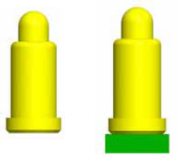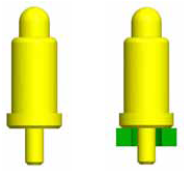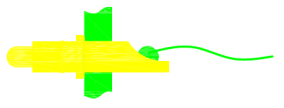pogopin reflow solderingpogopin wave soldering
The pogo pin is an electronic component with elastic contact, which has three parts: plunger, spring, barrel. The barrel is generally used as a fixed part and is combined with other materials through various processes to form a channel for current or signal transmission. Pogo pins have a wide range of applications. For example, TWS/OWS headsets, tablets, hearing aids, handheld devices and other products. When applying pogo pins to different products, we usually need to combine the product’s internal structural design analysis and adopt different assembly methods.
-
Pogopin connection assembly method

pogopin reflow soldering

pogopin wave soldering
Pogo pin assembly and connection methods generally include welding wires, PCB board welding, or elastic butt assembly. PCB board welding (SMT process) is the most commonly used method at present. Because of its obvious advantages such as automated production, large-scale production, and high efficiency. Moreover, the quality is stable and the product space is compact, which is in line with the current development trend of electronic products. SMT (Surface Mounted Technology) technology is also divided into two processes: reflow soldering and wave soldering.
The main things to pay attention to in PCB welding are the flatness and dimensional accuracy of the product. Because the welding machine automatically picks up and places materials. If the bottom of the product is uneven or the size is inaccurate, placing it on the board may cause the product to deflect, skew, etc., affecting the welding quality.For welding wires, the spring pins are usually fixed first and then assembled on the plastic parts or PCB. The wire is soldered to the end of the PCB.

pogopin is soldered to PCB, wire is soldered to PCB

Solder the wire directly to the tail of the pogopin
What you need to pay attention to when wire welding is the welding time or temperature. Generally, welding wires use high-temperature solder, which will heat up the plastic parts over time, causing them to melt. As a result, the spring needle cannot be fixed on the plastic part, and there is a risk of the needle withdrawing. For products that are generally small in size or high in density, we usually solder the PCB to transfer the bonding wires. In this way, the welding temperature will not be directly transmitted to the plastic parts and will not affect the assembly of spring pins and plastics.
-
Professional magnetic pogo pin connector solution provider
With 15 years of experience in product development and production, CFE consistently adheres to an attitude of excellence in quality. Every aspect from product development to production is subject to strict requirements and full control to ensure product shipment quality. CFE currently has specialized solutions for some high current 3-60A industries. For new industry trends, CFE has developed a high-voltage and high-current charging pin solution for new energy vehicle charging. In addition, CFE also provides customers with a one-stop customized PogoPin magnetic connection charging solution. CFE provides innovative solutions for customer products to achieve product upgrades and technological innovation.




